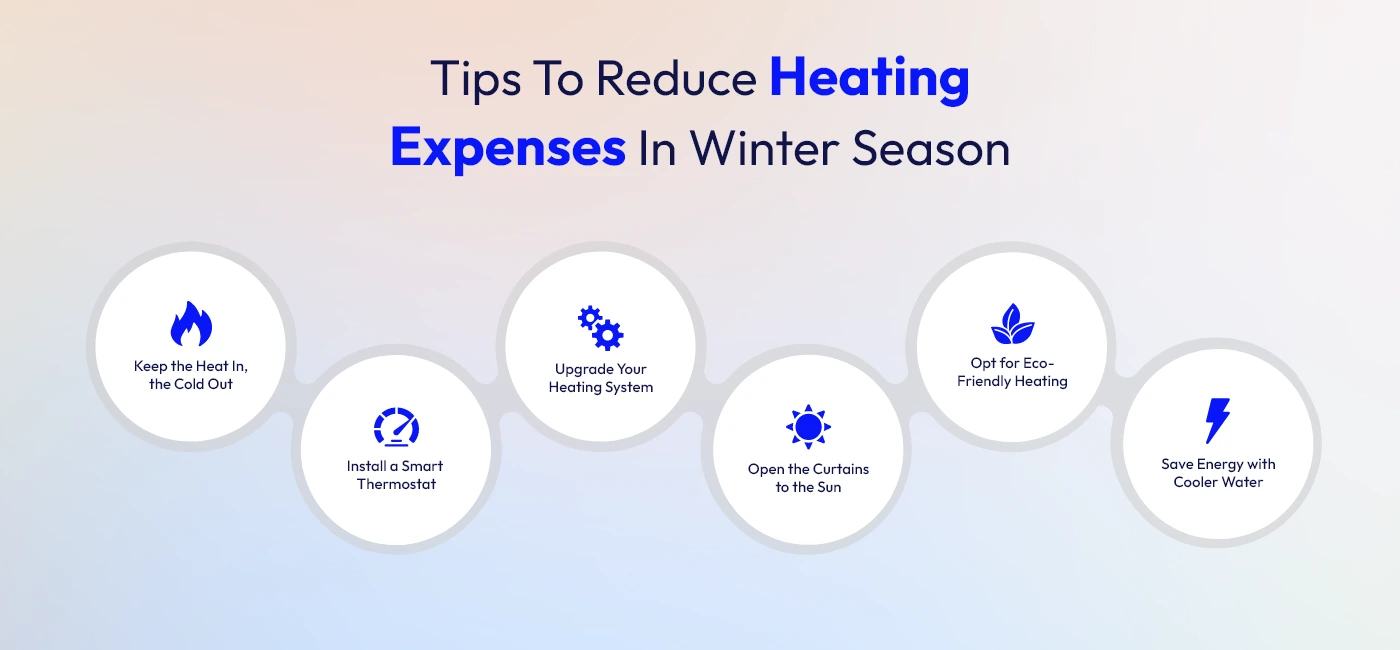Winter brings a fall in temperature and rise in heating expenses with it. It demands to heat your home and feel comfortable during the season. But, heating your home during colder months can take up a significant portion of your energy bill and cost you a lot. However, there are ways that can reduce the heating costs in winter without losing the comfort.
Here, we will talk about such ways that can keep your home warm along with cutting down on energy expenses this cold! We will discuss in details on insulating windows, using programmable thermostat, and sealing drafts.
Read below a few practical tips for reducing heating costs in winter.

1. Seal Drafts and Improve Insulation
Air leaks are a major reason homes lose heat. With drafty windows and poorly insulated walls, cold air can enter easily and warm air can outflow, making your heating system to work more efficient than before. The best way to reduce heating cost is to seal draft and upgrade insulation.
Check if insulation in walls, attics, and basements are matching the recommended levels of insulation. If your home is under-insulation, you must add more insulation. This helps in increasing energy efficiency and decreasing heating costs.
2. Set Programmable Thermostat
A programmable thermostat is the device that allows you to personalize your heating schedule, setting different temperatures for different day times. This helps prevent superfluous heating costs by dipping energy consumption when you’re away or sleeping. By lowering the temperature during these times, you can significantly reduce your energy bills.
Consider a smart thermostat adaptable to your schedule and adjustable according to the temperature automatically. You can also control some models from your phone, allowing you to change the temperature when you’re away.
3. Install Steadfast Heating System
A well-maintained heating system works more efficiently and uses less energy to heat your home. Its regular maintenance can keep your system in optimal condition. This lowers down the usage of energy and also, extends its lifespan.
Fixing small problems early can improve air quality for a healthier home and also, can save you from costly repairs later. Regular check-ups also help improve air quality for a healthier home. It is a good choice to hire a professional from a reliable service provider for annual maintenance. They would inspect heating pump, furnace, and boiler before extreme col
4. Use Natural Sunlight
Sunlight is a natural source to warm your residence during winter season. It is a free and easy way to keep your home warm during the daytime. To let sunlight come in, you must keep your curtains and blinds open, specifically on south-facing windows. It helps lower energy expenses and makes your home more comfortable.
While it’s a great choice to let sunlight in during the day and close curtains or blinds during the night time. This helps add extra insulation and save heat from escaping through windows.
5. Utilize Energy-Efficient Space Heaters
Keep your room warm without heating the entire house using an energy-efficient space heater. It can simply supplement your central heating system if you spend most of your time in one room. Select a heater with a thermostat to get rid of overheating and thus, save plenty of energy.
Look for safety features including automatic shut-off if it tips over or gets too hot, and ensure the heater is the perfect size for the room.
6. Decrease Water Heater Temperature
Water heating through geysers is quite common in every home in winter season. However, it accounts for a substantial portion of your energy bill. By lowering down the temperature on your water heater, you can cut energy consumption without much difference in coziness.
For an instance, the default temperature for most water heaters is 140°F, but decreasing it to 120°F is enough for most household requirements and can save a lot of energy.
The bottom line is, you can keep your home warm and cozy by following the above tips! All these are proactive ways to reduce heat loss, enhance efficiency, and make smart use of your heating system in Plainfield. Make small changes in your home and add significant savings over the winter months.
Insulate your doors, windows, walls and roofs properly to save money on heating in the winter. Open the curtains to let in sunlight during the day and close them at night. Heat only the room you use and consider a space heater for small spaces.
- To lower your winter electric bill in an apartment, try these tips:
- Use energy-efficient light bulbs.
- Seal doors and windows to block drafts.
- Use heavy curtains to keep heat in.
- Use a timer for outdoor lights to save energy.
Set the temperature lower to reduce cooling costs with central cooling. When you are outdoors We recommend using a programmable thermostat. Allows you to set defined schedules for connection and disconnection. This ensures that you use energy only when needed.
Setting the thermostat temperature to 15-18°C during the day and setting it at night can save money on heating. Wear warm clothes and use blankets to keep yourself comfortable and save energy in winter.
Turn on the oven when the temperature drops below 15 °C or 60 °F in cold weather. You can also start heating the house by installing a heating furnace or thermostat to regulate the indoor temperature, rather than relying on ovens or other appliances.






